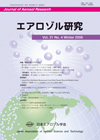All issues

Volume 16 (2001)
- Issue 4 Pages 268-
- Issue 3 Pages 180-
- Issue 2 Pages 98-
- Issue 1 Pages 4-
Volume 16, Issue 4
Winter
Displaying 1-9 of 9 articles from this issue
- |<
- <
- 1
- >
- >|
Feature Articles -Effect of Crystalline Silica on the Lung-
-
Yasuo MORIMOTO2001 Volume 16 Issue 4 Pages 268
Published: December 20, 2001
Released on J-STAGE: January 08, 2009
JOURNAL FREE ACCESSDownload PDF (493K) -
Yasushi SHINOHARA, Norihiko KOHYAMA2001 Volume 16 Issue 4 Pages 269-274
Published: December 20, 2001
Released on J-STAGE: January 08, 2009
JOURNAL FREE ACCESSDownload PDF (730K) -
Takako OYABU, Yasuo MORIMOTO, [in Japanese]2001 Volume 16 Issue 4 Pages 275-279
Published: December 20, 2001
Released on J-STAGE: January 08, 2009
JOURNAL FREE ACCESSDownload PDF (769K) -
Ken TAKAHASHI2001 Volume 16 Issue 4 Pages 280-284
Published: December 20, 2001
Released on J-STAGE: January 08, 2009
JOURNAL FREE ACCESSDownload PDF (642K) -
Oichi KAWANAMI, Hiroshi MOCHIMARU, Satoru ARAI2001 Volume 16 Issue 4 Pages 285-288
Published: December 20, 2001
Released on J-STAGE: January 08, 2009
JOURNAL FREE ACCESSDownload PDF (927K) -
2001 Volume 16 Issue 4 Pages 288
Published: December 20, 2001
Released on J-STAGE: January 08, 2009
JOURNAL FREE ACCESSDownload PDF (473K)
Research paper
-
Kazumi MIYAGI, Norihiko SAGAWA2001 Volume 16 Issue 4 Pages 289-298
Published: December 20, 2001
Released on J-STAGE: January 08, 2009
JOURNAL FREE ACCESSAn analytical model for aerosol behavior in gas bubbles is developed for interpretation of the process, in which gas bubbles move from a failed location toward an outlet of a coolant channel. Using the analytical model, input data for an analysis of a subsequent late process have been prepared, in which the gas bubbles rise from the outlet of the coolant channel to a water surface, splitting and coalescing through the water pool. The model for aerosol behavior can deal with gas release into the coolant channel, droplet formation by entrainment to gas flow in the channel, aerosol formation in the gas, and aerosol depletion by interaction of aerosols with droplets. Heterogeneous nucleation in the aerosol formation and interaction of size-distributed aerosols with droplets are incorporated in the model as well as the formation and interaction of single-size aerosols. The decontamination factor obtained from the model agrees with the previous water experiment at a region just above the coolant channel. The analytical model is shown to be capable of describing the aerosol depletion in the process.View full abstractDownload PDF (615K) -
Kazumi MIYAGI, Masanori FUKASAWA, Norihiko SAGAWA2001 Volume 16 Issue 4 Pages 299-304
Published: December 20, 2001
Released on J-STAGE: January 08, 2009
JOURNAL FREE ACCESSAn analytical model for aerosol behavior in gas bubbles is developed for interpretation of the process, in which gas bubbles move from an outlet nozzle simulating the pin bundle toward the surface of upper liquid pool. The model deals with aerosol depletion in large and small bubbles in a split/coalescence zone above a release zone in which globule bubbles are generated, and treats formation of liquid droplets and aerosol coagulation onto them in the split/coalescence zone. Input data are prepared by other analytical models for a foregoing process, in which released gas move from a location of fuel failure toward the outlet of pin bundle. Experimental results obtained with use of a large-scaled water pool are compared with those calculated with the model and the input data. The comparison shows that the developed model is capable of describing the aerosol depletion in bubbles transferring from the release location in the pin bundle to the free surface of the coolant pool.View full abstractDownload PDF (545K) -
Hiroshi SETO, Ikue SAITO, Aya ONUKI2001 Volume 16 Issue 4 Pages 305-310
Published: December 20, 2001
Released on J-STAGE: January 08, 2009
JOURNAL FREE ACCESSLittle is know about indoor air pollution by plasticizer phthalic acid esters (PAEs). We developed a simple method the Internfacial Passive Adsorption (IPA) to determine the migratory rate of PAEs through the interface from building materials to the adsorbent attached to the surface. Authentic PAEs on the glass plate surface moved quantitatively to the adsorption disc (EmporeTM C18), which was fitted for Fick's law of diffusion. After the adsorption disc had been placed in contact with a vinyl sheet for 1 - 14 days, adsorbed PAEs were measured. The adsorbed amount of di(2-ethylhexyl)phthalate (DEHP) increased in proportion to the contact time, whereas the increase of diethyl phthalate (DEP) or di-n-butyl phthalate (DnBP) each day was larger during the first five days rather than afterwards. We speculated that the movement of DEP or DnBP from the material to the adsorbent was more rapid than that of diffusion in the material. The rate of movement increased together with temperature. A plot of log moving rate vs. the reciprocal of the temperature (1/T) gives a straight line with negative correlation. It was suggested that the moving rate of the PAE obtained by this method relates to the emission rate of the corresponding PAE into air. The IPA method can be used to “Evaluate the PAE emission potential of materials” and “Specify the PAE emission source in on-sites”.View full abstractDownload PDF (649K)
- |<
- <
- 1
- >
- >|